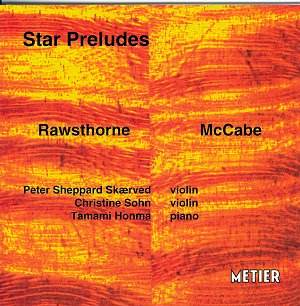This coupling of music by John McCabe and Alan Rawsthorne
is an intelligent one on more than one level. Aurally, as Peter Sheppard
Skærved correctly points out in his booklet essay, their work
may not sound immediately similar. It does however, share a highly impressive
clarity of expression allied with a rigorous and sophisticated approach
to the organisation of their material, every note and gesture having
its place. On another level, as a prominent member of the Alan Rawsthorne
Society, McCabe has been a tireless advocate of Rawsthorne’s music,
even through the shameful years of neglect his work suffered as a result
of so called "fashion". The result of this advocacy was the
publication of his authoritative study, "Alan Rawsthorne: Portrait
of a Composer" in 1999 (Oxford University Press).
I well remember, just a couple of years ago when McCabe
was the featured "composer of the week" on Radio Three in
celebration of his sixtieth birthday, he spoke out on Rawsthorne’s neglect,
commenting that the reputation for "greyness" which his music
seemed to have acquired could not be further from the truth. Fortunately,
at long last, the reality of this seems to have been recognised with
a fine series of recordings from both Naxos and ASV (the 1999 release
of Rawsthorne chamber music on Naxos 8.554352 featuring McCabe as pianist).
In compositional terms Rawsthorne was a late starter,
pursuing a career in dentistry before turning towards full time musical
study. As a result his international reputation did not take off until
he had reached his mid-thirties, yet this is perhaps the reason for
the degree of accomplishment evident in his early works. Both the Theme
and Variations for two violins, which secured his reputation in
1938, and the Symphonic Studies, his first acknowledged orchestral
work, are fully formed and unmistakably Rawsthorne in both their harmonic
and melodic language and the refinement of their conception. The Theme
and Variations is remarkable in its cogency and formal clarity,
the melodic transparency of Rawsthorne’s treatment of the variations
highly accomplished. The four movement Violin Sonata of twenty-one
years later is similarly taut in its construction, melodically imbued
with an air of bittersweet melancholy that was peculiar to Rawsthorne.
It is another fine work and a pity therefore that this performance does
not match up to that of the Theme and Variations, lacking warmth
in the violin sound and failing to fully capture the work’s particular
atmosphere, notably in the mysteriously questioning final movement.
This is not helped by the recording, the piano sounding particularly
dull and lifeless to the point that I began to wonder whether the pianist
was in the same room as the violinist.
Fortunately the McCabe works fare better in this respect,
played with fine commitment by Skærved, although again in Star
Preludes (recorded in the same venue as the Rawsthorne Sonata)
the sound of the piano can seem muffled, particular in its lower register.
Premiered by Erich Gruenberg and the composer himself in 1978, this
"space-scape" as Peter Sheppard Skærved describes the
opening and closing sections, propels the listener into an intellectually
formidable yet remarkably involving musical experience. Maze Dances
of five years earlier, impresses even more in this respect. Writing
a sixteen-minute work for solo violin is daunting in itself, but this
piece succeeds in grabbing the attention from the opening bars and refuses
to let go such is McCabe’s command of his material. He guides the listener
through an ever changing but strangely familiar musical landscape in
which shapes, melodies and images are skilfully woven into a satisfying
single movement span.
An excellent performance of Maze Dances and
Rawsthorne’s Theme and Variations, in which Christine Sohn joins
Skærved, make these two works the highlight of this disc. It is
a great shame that the Violin Sonata does not quite achieve the
same standard but nevertheless, this is a worthwhile disc which it is
to be hoped encourages the same advocacy of McCabe’s little recorded
chamber output as Rawsthorne’s has received in recent times.
Christopher Thomas

![]() Peter Sheppard Skærved
and Christine Sohn (violins)
Peter Sheppard Skærved
and Christine Sohn (violins) ![]() METIER MSV CD92029 [61:56]
METIER MSV CD92029 [61:56]